1. ActiveBatch Workload Automation
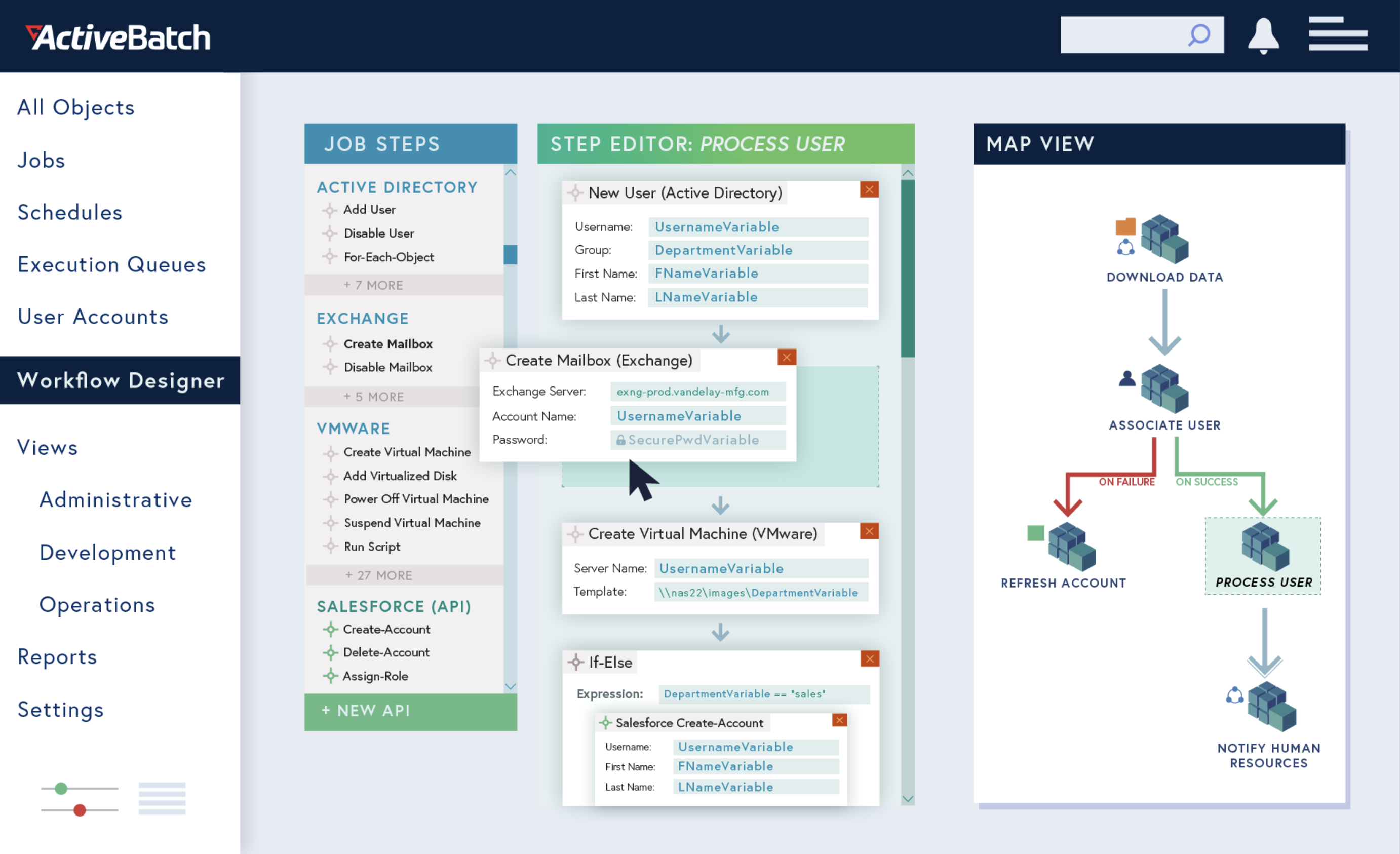
Overview
ActiveBatch Workload Automation makes it easy to orchestrate workloads across the organization, including batch jobs, event-based workloads, ad hoc jobs and more. ActiveBatch can easily connect to any endpoint in your tech stack through pre-built integrations or by creating connectors with the Super REST API adapter. This enables users to build and manage cross-platform processes, without time-intensive custom scripting. Manage data and dependencies across multiple systems, regardless of technology, and integrate batch jobs into end-to-end processes.
ActiveBatch provides hundreds of prebuilt job steps within its Integrated Jobs Library that can be used to build end-to-end workflows across systems and applications. Many of these job steps are platform-neutral and do not require custom scripts. This allows IT to consolidate and coordinate processes across disparate technologies including SAP, Windows apps suite, Oracle and IBM. ActiveBatch also supports connections to API endpoints for integrating virtually any tool.
Features
ActiveBatch is highly extensible, allowing IT to apply its powerful features and capabilities to workloads and batch jobs across the enterprise. ActiveBatch’s key capabilities include:
-
Granular date/time and interval-based scheduling with support for business calendars and timezones
-
Event-based automation for real-time processes and accurate data
-
Machine resource optimization to reduce delays and cloud/VM costs
-
Extensive reporting and analytics for auditing, troubleshooting and more
-
Custom alerting on numerous conditions for faster response times
-
Workflow constraints and dependencies to improve reliability
-
Super REST API Adapter to connect to any endpoint in your tech stack
-
Health Service that proactively monitors system performance and sends optimizations through the Action Center
The ActiveBatch job scheduler provides advanced batch scheduling and process automation capabilities across a diverse set of operating systems including Windows, UNIX, Linux, OpenVMS, IBM iSeries AS/400 and more. This enables developers and operations teams to automate batch jobs, IT processes, share data and manage complex dependencies across enterprise systems and applications.
Pros
ActiveBatch provides highly reliable workload automation software with
excellent customer support through its White-Glove Onboarding and Customer Success teams. ActiveBatch provides low-code and no-code development options, dozens of native integrations and is designed for high-volume workloads.
Cons
ActiveBatch can have a high learning curve as it is a very powerful solution that provides dozens of
IT automation features out-of-the-box. However, ActiveBatch does provide training through its on-demand ActiveBatch Academy courses, with an extensive knowledge base and 24/7 access to ActiveBatch experts.
Visit
www.ActiveBatch.com to learn more.
2. Redwood RunMyJobs
Overview
Redwood RunMyJobs is a workload automation solution that enables users to manage and monitor unattended processes across hybrid and multi-cloud environments. RunMyJobs was built ground-up for the cloud and is available as a SaaS solution and for on-premises deployments. With RunMyJobs, updates are automatic and scalability is both seamless and highly reliable.
Redwood offers event-driven process automation through a low-code graphical editor with an extensive library of templates and wizards. By streamlining the development process, IT teams deliver accurate data and results faster than ever.
Features
Redwood RunMyJobs provides dozens of features and capabilities that make it easy to orchestrate and manage workloads across complex IT environments. Redwood’s native functionality in cloud environments provides scalability and hands-off infrastructure while special features for developers streamline DevOps right out of the box.
-
Deep integrations with enterprise ERPs, including SAP, Oracle, Microsoft and more
-
Dynamic workload balancing
-
Schedule across multiple time zones
-
Publish automated processes as microservices or interactive service endpoints
-
Intuitive user interface can be accessed from any browser without installation
-
Fully integrated MFT
-
Built-in SLA monitoring with early alerting
-
API wizards simplify the use of REST and SOAP services
-
Support for over 25 scripting languages including Python, R and PowerShell
-
Source control, rollback and audit trails for complete lifecycle management
-
Cascade changes to reusable process steps, sequences, calendars and more
Pros
Redwood provides all of its connectors out-of-the-box so users can integrate with and automate any application. Its fully hosted infrastructure and simple pricing plans make it easy to scale so IT can meet the needs of growing businesses and established enterprises.
Cons
Reporting capabilities can require custom scripting at times.
Visit www.Redwood.com to learn more.
3. HelpSystems JAMS Scheduler [Top]
 Image: jamscheduler.com
Image: jamscheduler.com
Features
-
Cross-platform scheduling with direct integrations for SAP applications and systems
-
Central monitoring for all batch processes
-
Alerting for faster responses to unexpected issues
-
Load balancing including off-loading to optimize resource usage
-
Job distribution to easily meet spikes in demand
-
Recovery and rerun jobs address common issues
-
Granular permissioning and clear security roles to prevent unauthorized changes
-
Run parallel jobs or sequential jobs with input variables
-
Custom views and filters including audit trails and historical statistics
-
Featured integrations include SQL Server, SAP, Informatica and Banner
Pros
JAMS is a solid tool for managing batch processes. JAMS provides a single set of tools that can be applied to a variety of automation use cases including financial batch processing, ETL, ERP automation, business intelligence and more.
Cons
Response times can be slow, possibly due to connectivity issues or frequency of updates. Troubleshooting scripts can be time-consuming in JAMS.
Visit www.JamsScheduler.com to learn more.
4. Activeeon Batch Scheduling [Top]
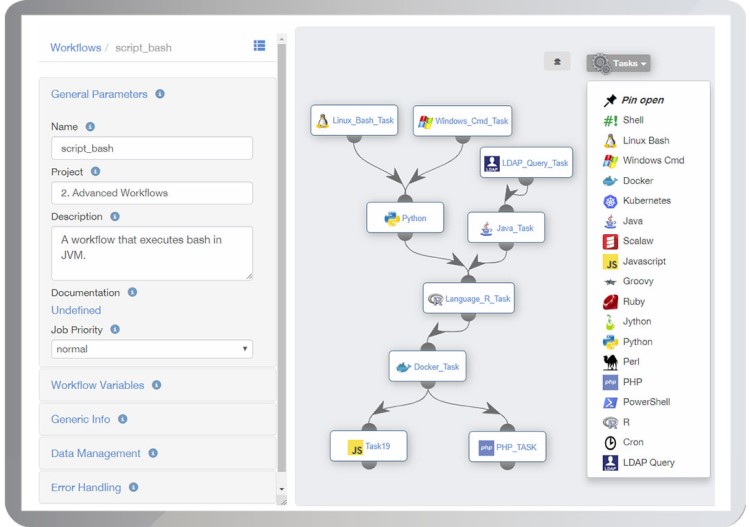
Image: activeeon.com
Features
-
Scalable batch scheduling with resource abstraction
-
Multi-cloud integration capabilities for hybrid or cloud-native environments
-
Granular allocation of compute resources
-
Intuitive web-based UI that supports multiple languages
-
Time-based and event-based scheduling capabilities
-
Prebuilt connectors for common databases, including Oracle
-
Event-based alerting and notifications
-
Connect through Activeeon’s GUI, REST API or CLI
-
Activeeon’s Workflow Studio makes it easy to set dependencies between tasks
Pros
Activeeon provides a clean dashboard that makes it easy to quickly find job statuses and to edit job priorities. This includes a log panelboard for job output visualization that allows users to filter through all logs to identify issues. Activeeon also offers desktop agents and file transfer capabilities.
Cons
Activeeon is an open-source solution that works best in small- and mid-sized organizations.
Visit www.Activeeon.com to learn more.
5. BMC Control-M [Top]
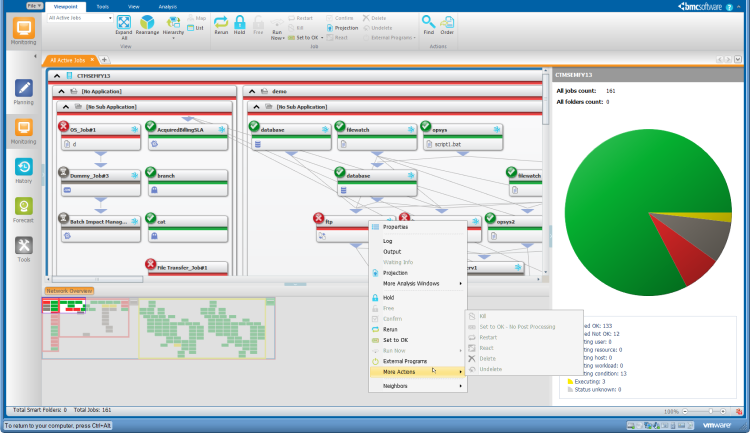 Image: BMC.com
Image: BMC.comFeatures
-
Implement on-premises or as a service
-
Jobs-as-code through REST APIs and JSON to extend DevOps goals
-
Workflow orchestration for CI/CD pipelines
-
Integrations for AWS, Azure and Google Cloud
-
Deploy on-premises, in the cloud or in hybrid IT environments
-
Automate conversions through existing schedulers
-
Intelligent analytics for proactive SLA management
-
Ingest data from Hadoop, Spark, EMR, Snowflake and Redshift
-
Integrate file transfers for greater visibility and control
-
Extensive simulation capabilities to resolve logic issues early
Pros
Control-M provides the stability needed to run large volumes of workloads, making it ideal for mainframes. Control-M also supports multiple interfaces including a robust web interface and mobile applications for iOS and Android. Installation is easy and an intuitive UI reduces the need for costly training.
Cons
Control-M upgrades can be cumbersome and time-consuming. Control-M also has a steep learning curve and does not include key features out-of-the-box.
Visit www.BMC.com to learn more.
6. Stonebranch Workload Automation [Top]
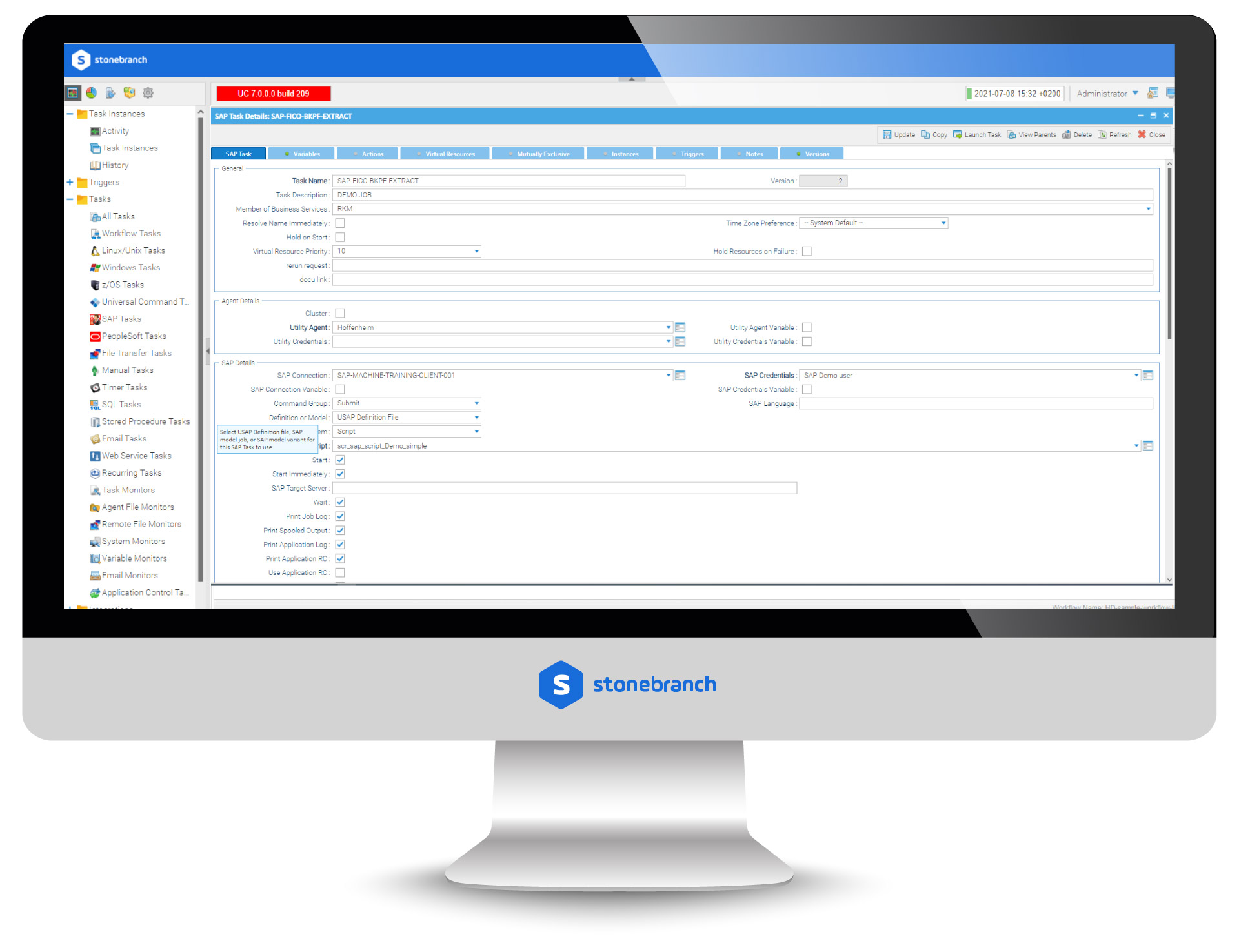 Image: stonebranch.com
Image: stonebranch.com
Features
-
Drag-and-drop workflow designer
-
Event-based automation for real-time processing
-
Container-based workloads for easier management
-
Managed file transfer capabilities
-
Build unique integrations or get existing ones in Stonebranch’s Integration Hub
-
Automated resource deployment
-
Native managed file transfer capabilities
-
SaaS or on-premises deployment
-
Visual dashboards and drill-down reports for real-time insights
Pros
Stonebranch is easy to install and to upgrade, largely due to its placement as a SaaS offering. With low-code development and an intuitive drag-and-drop interface, Stonebranch is easy to implement and to use.
Cons
Date/time scheduling offers basic functionality. Connectivity issues into Windows systems can degrade visibility.
Visit www.Stonebranch.com to learn more.
7. Broadcom CA Automic [Top]
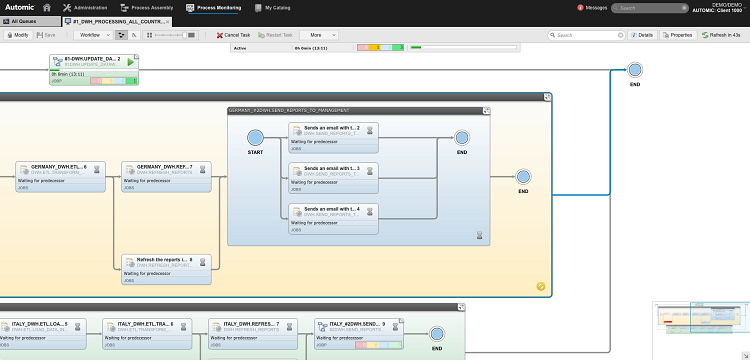 Image: sdtimes.com
Image: sdtimes.com
Features
-
Automation-as-code
-
Self-service for IT and business users, including data scientists
-
Prebuilt integrations for ERP, business intelligence and big data
-
Integrations for SAP Solution Manager, BusinessObjects and more
-
Marketplace for add-ons and templates
-
Comprehensive auditing of all instances and user activity
-
Resource abstraction to manage cross-platform infrastructure
-
Root cause alarms and remedial workflows
Pros
Easy deployment with ready-to-use integrations that make batch processing and workload orchestration reliable and efficient, especially for mainframes and SAP environments. Automic’s stability also makes it a reliable platform.
Cons
Automic’s user interface can make it difficult to manage complex processes while customizing workflows often requires custom coding, which can be time-consuming and error-prone.
Visit www.Broadcom.com to learn more.
8. Tidal Workload Automation [Top]
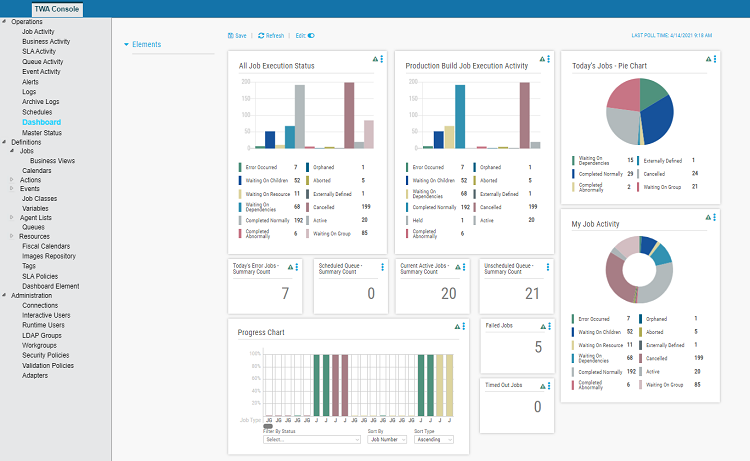 Image: g2crowd.com
Image: g2crowd.comFeatures
-
Centralized process management and error handling
-
Global business calendars and events
-
Manages outage windows and audit logs for operational security
-
Out-of-the-box disaster recovery
-
Single interface for managing workloads across the organization
-
Business views for monitoring processes in real-time
-
Kanban, PERT, Critical Path and Radial views
-
SLA monitoring with custom thresholds for alerts
-
Mobile device application enables users to manage workloads on the go
-
Date/time scheduling, event-based scheduling and dependency-based processes
Pros
Tidal’s cross-platform approach enables IT operations teams to orchestrate batch jobs and workloads across ERP, ETL, IoT, big data, microservices and more. Tidal is scalable without additional infrastructure costs, a benefit to organizations expanding into cloud environments.
Cons
Installation and updating can be time-consuming, including deploying agents. Difficulties accessing logs can make root-cause analysis difficult in some cases.
Visit www.tidalsoftware.com to learn more.
9. IBM Workload Automation [Top]
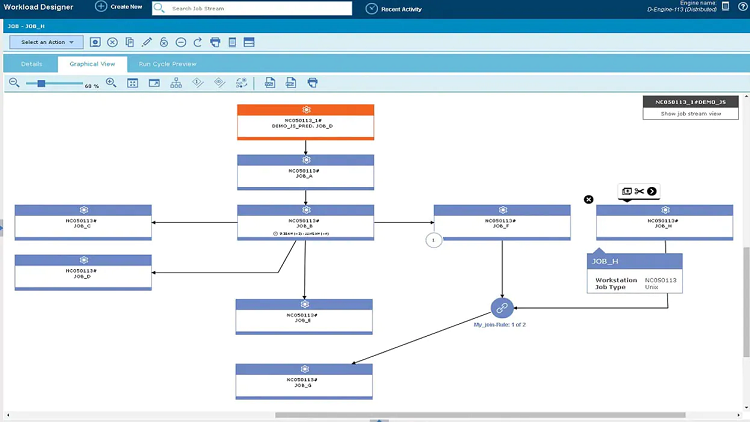 Image: ibm.com
Image: ibm.com
Features
-
Intuitive dashboard
-
Built-in recovery logic for advanced rerun flexibility
-
Self-service automation to run and monitor ad hoc processes
-
Deploy workloads and more in containers
-
Variables to pass data downstream
-
Supports REST API, SOAP and Java interfaces
-
Release management including development, test and deployment
-
35+ prebuilt integrations including SAP, Oracle, PeopleSoft, Informatica and Hadoop
-
Real-time monitoring and recovery
Pros
IBM Workload Automation is well-designed for distributed mainframes and cloud deployments. Its scalability and performance stability enable IBM WLA to manage high volumes in complex environments.
Cons
IBM Workload Automation can be difficult to connect to other schedulers, which can prevent consolidation and coordination of key tasks.
Visit www.IBM.com to learn more.
10. VisualCron [Top]
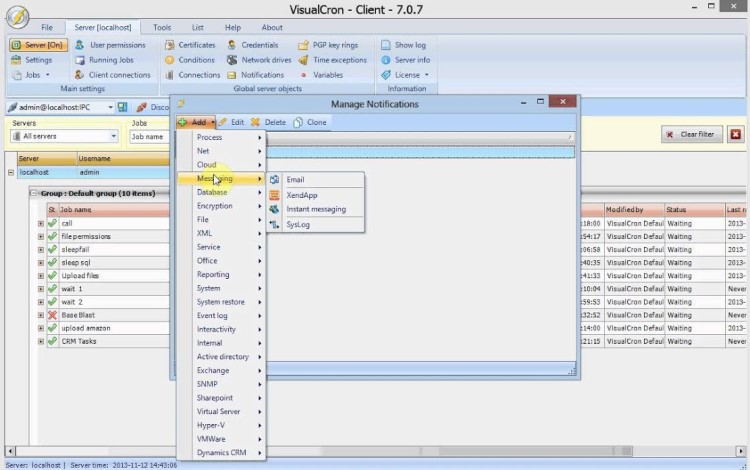 Image: visualcron.com
Image: visualcron.comFeatures
-
Clocks and calendars for flexible scheduling
-
Trigger jobs based on external events
-
Error notifications
-
Supports dozens of common protocols and services
-
Event-based and date/time triggers
-
Extended logging for faster troubleshooting
-
Flow and error handling
-
Low-code drag-and-drop workflow builder
-
Supports .NET, REST and SOAP APIs for flexible interactions
Pros
VisualCron provides an easy-to-use interface so that even users with little programming experience can build and execute automated tasks. VisualCron’s product development is based on feature requests from customers and offers a Basic license with low pricing that makes it easy to get started for organizations of all sizes.
Cons
VisualCron has limited functionality when compared to other products on this list. However, VisualCron is a reliable and cost-effective tool for small- and mid-sized businesses.
Visit www.visualcron.com to learn more
Find The Best Batch Scheduler For Your Organization
Modern batch scheduling solutions include workload automation tools,
enterprise job scheduling, service orchestration and more. There is a lot of overlap between different platforms and what works best for your organization will likely depend on integration capabilities and the vendor’s own product roadmap.
As IT and business needs evolve, the right batch scheduler for your organization will reliably connect to any endpoint, likely through the use of API adapters so that you can easily address future challenges and new enterprise applications. When looking for a batch scheduler, be sure to ask about the product’s roadmap. Find out what new capabilities a batch scheduler will provide in the coming years, and if the vendor will be there to support your team along the way.